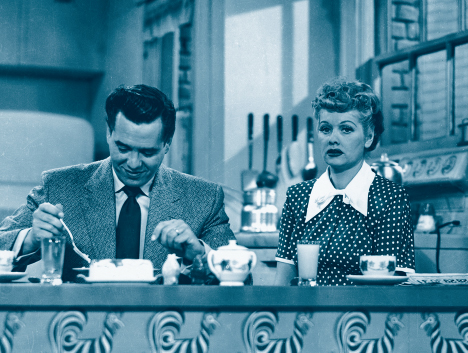Entertainment: Comedy
Printed Page 234
Originally many new programs on TV were broadcast live and are therefore lost to us today. The networks sometimes did manage to "save" early 1950s shows through poor quality kinescopes made by using a film camera to record live TV shows off a studio monitor. However, the producers of I Love Lucy decided to preserve their comedy series by filming each episode, like a movie. This produced a high quality version of each show that was far superior to any kinescope (which today would be like saving an American Idol episode by shooting the TV screen in our living room with a video camera). In 1956 videotape was invented, and many early comedies were preserved this way, allowing networks to create a rerun season in late spring and summer, thereby reducing the number of episodes produced each year from thirty-nine live broadcasts to about twenty-four taped programs.
In capturing I Love Lucy on film for future generations, the program’s producers understood the enduring appeal of comedy. While a number of comedy programs and ideas were stolen from radio, television eventually developed its own long history with comedy, which became a central programming strategy for both the networks and cable. TV comedy has been delivered to audiences through sketch comedy and situation comedy (sitcom).
Sketch Comedy
Sketch comedy was a key element in early TV variety shows, which also included singers, dancers, acrobats, animal acts, stand-up comics, and ventriloquists. Vaudeville performers, such as Milton Berle and Sid Caesar, were among television’s earliest sketch comedy stars. But sketch comedy had drawbacks. The hour-long variety series in which many of these skits appeared—such as the Perry Como Show (1948–63) and the Carol Burnett Show (1967–79)—were harder to sustain than half-hour sitcoms. Unlike the stability of a sitcom with its recurring characters and reusable sets, sketch comedy often required a whole new concept each week, with new characters and new, expensive sets. Today, however, the legacy of sketch comedy endures in programs like NBC’s long-running Saturday Night Live (1975–).
Situation Comedy

Until recently, the most dependable entertainment program on television has been the half-hour situation comedy (sitcom), such as I Love Lucy, Seinfeld, and How I Met Your Mother. Unlike many sketch comedy routines, a sitcom features a recurring cast (in fact, an early popular sitcom, The Honeymooners, developed first as a sketch comedy on a 1951 variety show). Each episode typically establishes a situation, complicates it, develops increasing confusion among its characters, and then usually resolves the complications.1 In some sitcoms, character development is downplayed in favor of zany plots; others will feature a personal problem or family crisis that characters must solve—and through which they develop. In addition to the traditional workplace or domestic sitcoms, some comedies today may also mix dramatic and comedic elements. This blurring of serious and comic themes has created a hybrid, sometimes called dramedy, which includes such series as The Wonder Years, Northern Exposure, and Desperate Housewives on the traditional networks, Royal Pains on basic cable, and Weeds on premium cable.